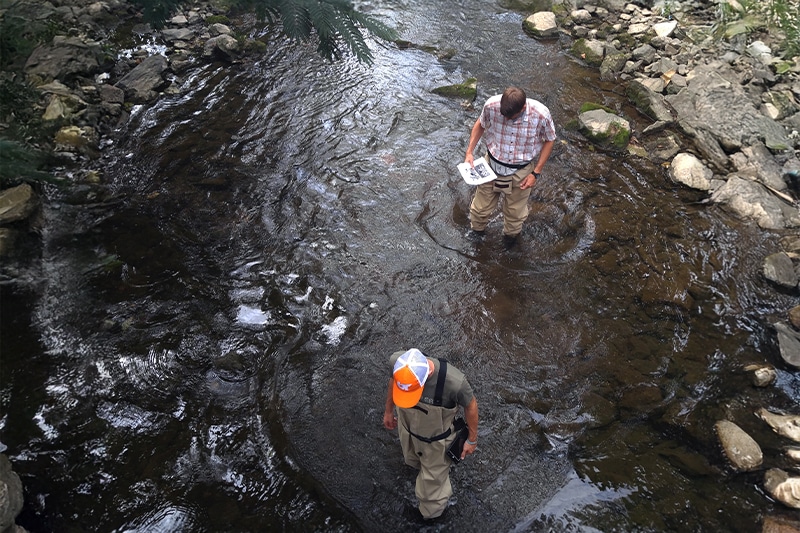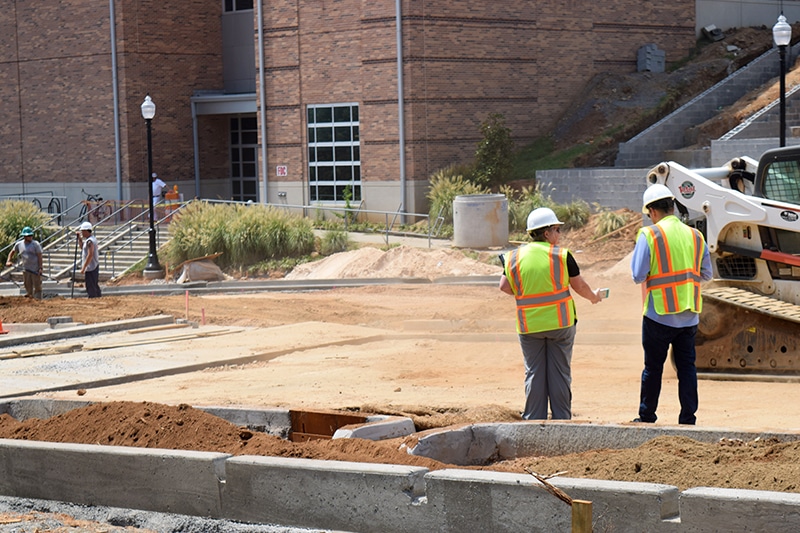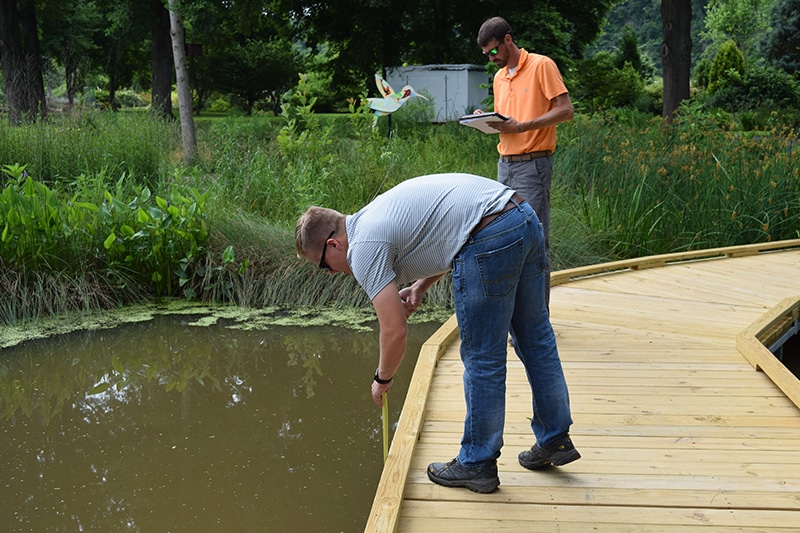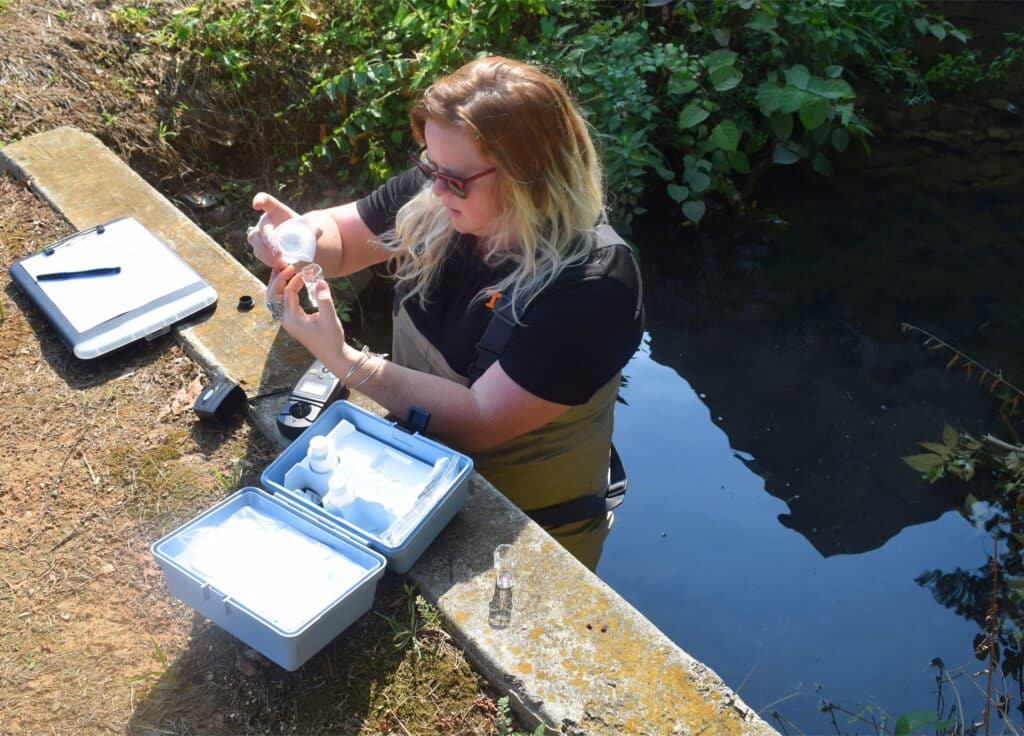when it rains, it drains – responsibly
Stormwater Management
Stormwater Management protects campus and community waterways by reducing pollution in rain runoff through careful planning, infrastructure, and education. In addition, the University of Tennessee, Knoxville follows state and federal environmental regulations to actively manage stormwater, promoting a healthier and more sustainable campus environment.
Clear waters, clean future
The University of Tennessee, Knoxville manages a Phase II Municipal Separate Storm Sewer System (MS4) under the State of Tennessee’s National Pollutant Discharge Elimination System (NPDES) permit. This permit comes from the Tennessee Department of Environment and Conservation, following requirements set by the Environmental Protection Agency under the Clean Water Act of 1972. The MS4 focuses on improving(or at least maintaining) the quality of surface waters by reducing pollutants in stormwater runoff, which increases as urban development expands. Because polluted runoff often flows through MS4s and enters local water bodies untreated, it poses significant risks to both environmental and public health.




STORMWATER MANAGEMENT PLAN
To prevent harmful pollutants from entering an MS4 through runoff or dumping, operators must obtain an NPDES permit and create a Stormwater Management Plan that includes six key components. Together, implementing and enforcing these components forms the foundation of the Stormwater Management Plan, as outlined below.
Public Education and Outreach
Public Participation and Involvement
Illicit Discharge Detection and Elimination
Construction Site Stormwater Runoff Control
Post-Construction Stormwater Management for New Development and Redevelopment
Pollution Prevention and Good Housekeeping for University Operations
To achieve our Stormwater Management goals, we take a comprehensive approach that includes several key strategies. First, we ensure compliance with all applicable state and federal water resource regulations. We also provide a regulatory framework that guides development while minimizing environmental impact. In addition, we promote low-impact development to protect the natural hydrologic cycle, actively manage our growing stormwater infrastructure, and engage the community through public participation and educational outreach events.
Our Stormwater Management team hosts public comment meetings each year to discuss the Annual Stormwater Report. This report summarizes all campus stormwater events, maintenance activities, and policy changes from the previous fiscal year. Once completed, we publish the report to the State of Tennessee. We welcome the campus community to review the report and encourage comments, suggestions, or questions on any aspect of it.

All Vols Can Help!
Our Stormwater team may be small in staffing, but with more than 20,000 people on campus each day, your eyes and ears make a big difference. If you spot flooding, clogged drains, erosion, or any other stormwater-related issue, let us know.
Together, we can keep campus safe, clean, and sustainable.
Big Impact, Mini Train: Stormwater Made Simple
Curious how UT Facilities Services is working to keep our campus and local waterways clean during a rainstorm? Hop aboard this Facilities Services Mini Train video to discover the big role stormwater management plays at the University of Tennessee, Knoxville! This short, engaging video breaks down how our team works behind the scenes to protect the environment and meet important state and federal regulations. It’s a quick ride with a powerful message—don’t miss it!
stormwater overview
What is Stormwater?
Stormwater is runoff that occurs during and after rainstorms, flowing from streets, construction sites, parking lots, buildings, and other areas directly into storm drains, which eventually lead to local streams and rivers. As this water travels, it can pick up pollutants along the way. To address this, the University of Tennessee, Knoxville has established a program aimed at protecting these waterways from contamination.
You might wonder why stormwater and sewer systems are separate. Unlike wastewater, stormwater is not treated at a wastewater treatment facility. Instead, it flows directly into streams and rivers. In contrast, wastewater (sewage) is sent to a treatment facility where it is cleaned before being released into the environment.
How to Reduce Pollution in Stormwater Runoff
• Dispose of waste properly
• Place litter in proper containers
• Never dump anything into a storm drain
• Check vehicles for leaking fluids
• Recycle used motor oil
Current Structural Best Management Practices (BMPs)
- The campus uses 5 cisterns, totaling approximately 121,800 gallons, to capture stormwater and reuse it for irrigation. Additionally, once the West Campus Housing Phase 1 is complete, this water will also flush toilets and supply cold water for laundry.
- Throughout campus, 25 water quality units remove 80% of the Total Suspended Solids (TSS) from stormwater.
- The parking garages contain oil-water separators that filter out hydrocarbons.
- Seven rain gardens operate across campus, covering 20,009 square feet.
- Also, permeable pavers cover 35,108 square feet, allowing stormwater to infiltrate instead of running off. On the pedestrian bridge, these pavers capture stormwater and slow the rate of discharge.
- Underneath street trees, 118 bio-retention structures called Silva Cells capture and retain stormwater for uptake by the trees.
- The campus has installed 9 green roofs, covering a total of 47,564 square feet.
- Grassed swales stretch 895 feet, allowing stormwater to infiltrate and reducing peak discharge.
- Vegetated filter strips extend 7,670 feet, slowing overland flow and improving water quality before it reaches receiving waters.
- Finally, 3 dry detention basins and vaults slow peak stormwater discharge.
ONE CALL AWAY, 24 HOURS A DAY
Emergency Repairs can be reported to Facilities Services One Call at 865-946-7777 24 hours a day.
FEATURED STORMWATER UPDATES
It Takes a Volunteer
Facilities Services is made up of more than 600 individuals
who work tirelessly to keep campus running 365 days a year.
